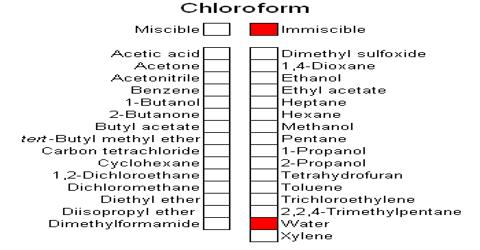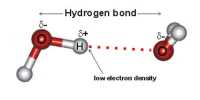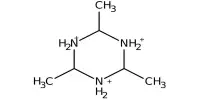Test of Purity of Chloroform:
Chloroform has transparent and colorless, neutral to test paper, non-irritating when inhaled, and should evaporate entirely, leaving no residue or smell on a glass surface. Pure chloroform has boiling point 61-620C.
Physical Purity: CHC13 is a colorless liquid having a boiling point of 62°C. Pure chloroform is boiled & distilled at 62°C. If any impurities are mixed with it, its boiling point also varies-chloroform boils at a higher temperature than 620C.
Chemical Purity: To assure purity of chloroform. AgNO3 is used. In presence of O2, chloroform produces phosgene gas and HCl. AgNO3 reacts with HCl and produce white precipitant of AgCl.
AgNO3 + HCl = AgC1↓ (white) + HNO3
Chloroform should have a particular gravity of from 1.491 to 1.525, enormously transparent and colorless, unbiased to test paper, non-irritating when inhaled, and should evaporate completely, leaving no residue or smell on a glass surface. To test the purity of chloroform, shake some of it in a well Stoppard bottle along with oil of vitriol (colourless). Pure chloroform has boiling point 61-620C. If any trace of oils is present, the acid becomes more or less yellow, when allowed to stand; a darker line appears at the connection of the liquids.
When the yellow color appears, after being shaken and eminence still for a little time, the chloroform is poured off into another vial, where it is shaken anew, with another and a lesser segment of vitriol. If after some time, this appears colorless, the chloroform might be measured pure.
This is because in the presence of air chloroform is oxidized to phosgene. To prevent the formation of phosgene, they are stored in dark colored bottles. CHCl3 + ½ O2 → HCl + COCl2. Phosgene is represented as COCl2. This is toxic.
Use of Chloroform:
- It is used as an anesthetic in surgery. But it has harmful effects on the liver & the excessive use of it may threaten the patient’s life—because the difference between anesthetic dose & a lethal dose of it is very less. So, at present, it is not widely used in anesthesia.
- As an excellent solvent, it is used in wax, fats oils, resin & alkaloid industries.
- It is used as an anti-rodent agent.
- In a laboratory, it is used as a reagent & solvent.
- Used as raw material for chloropicrin & in aromatization of foul-smelling drugs.













